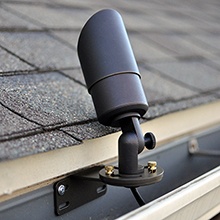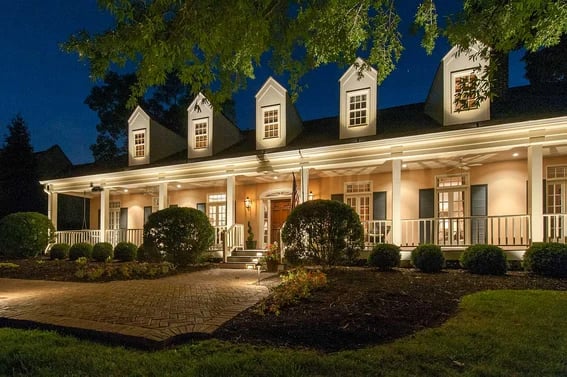Many homes have challenging architecture from a lighting standpoint. What do you do if you have detached dormers, detached or offset gables, or other architectural elements that simply cannot be lit from ground level? If you up-light most of the front facade on your home but leave the highest gable peak in the dark, does it really matter? Yes, it absolutely matters! Continue reading and learn why.

Gutter-mounted up-light fixtures are often required to create a consistent wash of warm light on the facade of a home. Without them, many homes have huge black holes where the house exists but isn’t being lit. Aside from creating a cohesive and balanced lighting effect, gutter-mounted lights usually hit the highest peaks, making the home appear larger and more impressive from the street. Many times, the most impactful attributes of a home’s architecture are at the peaks, making these specialty-mounted fixtures a must for anyone considering an architectural lighting system.
%20(1).jpg?width=567&height=395&name=Gutter%20Mounted%20Up%20Lights%20-%20Windows%20(1)%20(1).jpg)
Most of the time, the low-voltage wire that must run to these fixtures can be hidden in downspouts and gutters. Occasionally, wiring an up light in such a way isn’t possible, and these special situations call for some creative solutions that are custom to each project. If you have a two-story home or larger and you’re interested in having architectural lighting on it, chances are you’ll need some gutter-mounted up-lights. Make sure you hire a reputable outdoor lighting designer. Many landscaping companies offer landscape lighting or architectural lighting, but they aren’t lighting designers. When you hire someone who knows what they’re doing, they get the lighting effect right.
Uplighting your dormers makes a big difference. See the before and after photos of detached dormers, lit and unlit:
%20(1).jpg?width=567&height=377&name=Gutter%20Mounted%20Up%20Lights%20-%20Home%20Facade%20Before%20(1)%20(1).jpg)

Placement Strategies to Highlighting Architectural Elements
- Dormer Emphasis: For homes with detached dormers, placing up-lights at the base of each dormer can create a dramatic effect, drawing attention to these charming architectural features. This not only adds depth and dimension to your home's façade but also showcases the intricate details of the dormers.
- Gable Brilliance: Detached or offset gables are often eye-catching elements of a home's design. To bring these to life at night, position gutter-mounted lights at an angle that grazes the gable's surface. This technique creates shadows and highlights, emphasizing the gable's unique geometry and making it a focal point.
- Accentuating Special Elements: Beyond dormers and gables, consider other architectural elements like columns, arches, or decorative trim. These can also benefit from well-placed up-lights, enhancing the overall aesthetics of your home.
- Balanced Illumination: Achieving a harmonious lighting effect across your façade is crucial. Work with a professional designer to ensure that the placement of gutter-mounted lights creates a balanced and cohesive look, avoiding hotspots or areas left in the dark.
Wiring Considerations: Tackling the Challenges
When it comes to illuminating architectural elements using gutter-mounted up-lights, wiring is a crucial consideration. In most cases, the low-voltage wire that connects these fixtures can be discreetly hidden within downspouts and gutters. However, there are situations where creative solutions are required to overcome wiring challenges. Here's a closer look:
-
Traditional Concealment: The most common and seamless approach involves running low-voltage wiring through existing downspouts and gutters. This method not only hides the wires effectively but also protects them from the elements, ensuring long-term durability.
-
Unique Architectural Features: Some homes have architectural elements that make traditional wiring impractical. In such cases, a professional designer can devise custom solutions. This might include carefully concealing wiring within architectural details, such as decorative trim or molding, to maintain the aesthetic integrity of the home.
-
Wireless Technology: Advancements in lighting technology have led to the development of wireless options for architectural lighting. Battery-powered or solar-powered gutter-mounted up-lights are viable alternatives in situations where traditional wiring isn't feasible. These wireless fixtures offer flexibility in placement and can be controlled remotely for added convenience.
-
Expert Assessment: Assessing the specific wiring needs of your home's architecture is a task best left to professionals. They can conduct a thorough evaluation of your property, taking into account its unique features and challenges, to determine the most suitable wiring approach. This ensures a safe and effective installation.
-
Future Expansion: When planning your architectural lighting, it's wise to consider future expansion or changes. A well-thought-out wiring strategy should accommodate potential additions or modifications to your lighting system without the need for major rewiring.
Professional Design Ensures Optimal Lighting Effects
Customized Solutions
Efficiency and Aesthetics
Technical Expertise
Long-term Value
Partnering with a reputable outdoor lighting designer, like LightUp Nashville, is essential to achieve the best possible lighting effects for your home's architecture. Our expertise and attention to detail can transform your property into a nighttime masterpiece that enhances both curb appeal and security.
Not sure if up-lighting is best with your home's design? Light Up Nashville also specializes in recessed concrete lights.
If you have any questions or would like to discuss your lighting needs, please feel free to request a free consultation online.
We’re a local business that has been lighting up Nashville since 2012. Our team has years of experience creating and installing unique and elegant outdoor lighting designs and providing maintenance and repair services to homes and businesses across Middle Tennessee. Our award-winning company has been voted 1st in Nashville House & Home for landscape lighting for four consecutive years and Best of Houzz for the last three years.
Located in Goodlettsville, Light Up Nashville services Nashville, Brentwood, Franklin, Hendersonville, Gallatin, the surrounding areas, and beyond.

